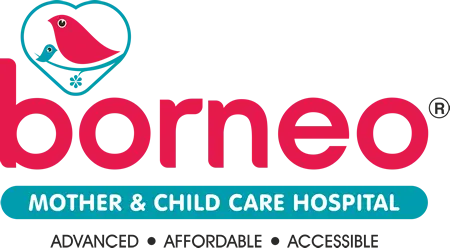As your pregnancy progresses, particularly into the third trimester, the anticipation of meeting your baby grows stronger each day. If your pregnancy journey has been identified as “high-risk,” this excitement might also be accompanied by questions or anxieties about the upcoming labour and delivery. It’s completely natural to wonder what childbirth might look like when extra care is needed.
My name is Dr. Vrushali Pillai, and as a Senior Consultant Obstetrician & Gynaecologist at Borneo Hospital, Thane – part of the Borneo Hospitals group serving families across Thane, Nashik, Chhatrapati Sambhaji Nagar, and Raipur City – my team and I are dedicated to guiding expectant mothers through all aspects of their pregnancy journey. Our dedicated obstetric and paediatric teams are highly experienced and our facilities are fully equipped to manage complex deliveries, always prioritising the safety and well-being of both mother and child. While a high-risk diagnosis requires careful medical attention, taking proactive steps in Preparing for Delivery with a High Risk Pregnancy can significantly ease your mind and empower you for the experience ahead. This guide offers practical steps to help you feel more informed and ready.
Understanding Potential Differences in Your Delivery Journey
One of the first steps in preparation is understanding why more detailed planning is beneficial. A Delivery with a High-Risk Pregnancy might unfold differently than a low-risk one. Potential differences could include:
- Timing: There might be a medical reason to plan delivery before your actual due date (preterm birth) or schedule an induction around your due date.
- Mode of Delivery: There could be a higher chance that labour needs to be induced (started artificially) or that a Caesarean section (C-section) delivery is recommended for safety.
- Monitoring: You and your baby will likely receive more intensive monitoring during labour and birth.
- Neonatal Support: There’s an increased possibility that your baby might need specialised medical care in our Neonatal Intensive Care Unit (NICU) immediately after birth.
Understanding these possibilities isn’t meant to cause worry, but rather to highlight why thoughtful preparation – mentally, emotionally, and practically – is so valuable. It allows you and your medical team to be ready for various scenarios.
Step 1: Communication is Key – Talking with Your Healthcare Team
Open and ongoing dialogue with your obstetrician at Borneo Hospital is fundamental when Preparing for Delivery with a High-Risk Pregnancy. Don’t wait until the last minute; start these conversations well before your due date.
Discuss Your Birth Preferences & Questions:
While flexibility is vital, discussing your hopes and concerns helps your team understand what’s important to you.
Essential Questions to Ask:
- Given my specific condition, when do you anticipate delivery might be recommended?
- What mode of delivery (vaginal birth or C-section) do you think is likely safest for me and the baby, and why? What are the specific benefits and risks involved?
- What level of monitoring should I expect during labour? Will I be able to move around?
- Are there specific pain relief options you would recommend, or any I should perhaps avoid?
- What plans are in place if labour doesn’t proceed as expected or if complications develop?
- Who will be present from the medical team during delivery (e.g., specific specialists, a paediatrician/neonatologist)?
Borneo Hospital’s Collaborative Approach:
We believe in partnership. Our team is committed to clear communication, explaining the medical reasoning behind recommendations, and ensuring you feel heard and involved in decisions about your care plan.
Step 2: Familiarising Yourself with Delivery Options & Potential Interventions
Knowing what might happen can make the actual experience feel less overwhelming.
Mode of Delivery:
Depending on your specific high-risk factor(s), your doctor will discuss the safest approach. Sometimes, conditions like complete placenta praevia make a planned C-section necessary. In other cases, a trial of vaginal labour under close observation might be possible. Understand the recommendation and feel comfortable asking questions.
Labour Induction:
Your doctor might recommend inducing labour if it’s medically safer for you or the baby to deliver sooner rather than wait for labour to start naturally (e.g., due to pre-eclampsia, certain diabetic conditions, or concerns about baby’s well-being). They will explain the methods used.
Assisted Vaginal Delivery:
Sometimes, during the pushing stage of a vaginal birth, a bit of help using instruments like forceps or a vacuum cup may be needed to deliver the baby safely and quickly.
Intensive Labour Monitoring:
Be prepared for potentially more monitoring. This usually means continuous electronic foetal monitoring (CTG) to track the baby’s heart rate closely. It might also involve more frequent checks of your vital signs (blood pressure, pulse, oxygen levels) depending on your condition. This close watch is purely for safety.
Step 3: Preparing for the Possibility of Neonatal Care (NICU)
Acknowledging that your baby might need specialised care is an important part of Preparing for Delivery with a High-Risk Pregnancy.
Understanding the Potential Need:
Prematurity or certain health conditions identified during pregnancy can mean a baby requires NICU admission after birth.
What is the NICU?:
Briefly, it’s a Neonatal Intensive Care Unit – a specialised hospital ward with advanced equipment and highly trained staff dedicated to caring for newborns who need extra medical support, such as help with breathing, feeding, temperature control, or treatment for specific conditions.
Borneo Hospital’s NICU Expertise:
We want to reassure you that both our Thane and Nashik branches are equipped with state-of-the-art Level III NICU facilities. This signifies the highest level of neonatal care. We have advanced technology like ventilators, CPAP machines, specialised incubators, and sophisticated monitoring systems. Critically, our NICU is staffed 24/7 by an expert team of neonatologists (like myself), highly skilled neonatal nurses, respiratory therapists, and other specialists focused entirely on the care of these vulnerable infants. This readiness is a cornerstone of our high-risk pregnancy programme.

Emotional & Practical Aspects:
If NICU admission happens, the team will keep you fully informed. You’ll learn about visiting, how you can bond with and participate in your baby’s care (like providing expressed breast milk – we offer strong lactation support), and the emotional journey involved. Knowing this possibility exists can help you prepare mentally.
Familiarisation:
Ask your doctor if learning more about the NICU environment at Borneo beforehand (perhaps via photos or a brief explanation) is possible, as this can sometimes ease anxiety.
Step 4: Getting Practically Prepared
Tackling practical tasks early leaves you free to focus on yourself as labour approaches.
The Hospital Bag:
- Pack well in advance – aim for around 34 weeks gestation. Consider including:
- Comfortable clothing for yourself (think layers, front-opening tops, comfortable trousers/gowns). Pack for a potentially longer stay than anticipated. Essential toiletries.
- Basic items for baby (vests, sleepsuits, nappies, swaddling cloths – check what Borneo Hospital provides).
- Items for your birth partner if they plan to stay.
- Crucial: Your ID, insurance information, hospital notes/file. Phone and charger (a long cord is helpful!).
- Consider expressing supplies if planning to breastfeed and NICU is a possibility.
Logistics:
Plan your journey to the hospital – know the route, have transport arranged (and a backup). Organise reliable care for older children well ahead of time. Keep important phone numbers easily accessible.
Hospital Familiarity:
Understand Borneo Hospital’s admission process, parking, where to go upon arrival (day vs. night), and basic visiting policies for the maternity ward and potentially the NICU.
Financial Awareness:
Clarify anticipated costs, insurance coverage, and payment procedures with the hospital’s billing department beforehand to avoid unexpected financial stress.
Step 5: Nurturing Mental and Emotional Readiness
Your emotional state plays a significant role in how you experience labour and delivery.
Acknowledge Your Feelings:
It is perfectly normal and understandable to feel anxious, scared, or stressed when Preparing for Delivery with a High-Risk Pregnancy. Allow yourself to feel these emotions without judgement. Talking about them helps.
Focus on What You Can Influence:
While you can’t control every aspect of labour, you can control being informed, making practical preparations, communicating effectively with your team, and using coping strategies. This focus can be empowering.
Use Coping Mechanisms:
Practice relaxation techniques you may have learned – deep breathing exercises, mindfulness, positive affirmations. Recall your inner strength.
Lean on Your Support System:
Talk openly with your partner, trusted family members, or friends. Let them know how you’re feeling and how they can best support you (emotionally and practically).
Maintain Realistic Positivity:
Trust in the skills and dedication of your medical team at Borneo Hospital. Focus on the shared goal: the safe arrival of your baby. Try to balance awareness of potential challenges with confidence in the care you will receive. This mindset is useful towards managing the process.
Consider Relevant Antenatal Education:
If available, classes focusing on C-sections or managing complex births can provide valuable information and coping tools.

Step 6: Thinking Ahead to Postpartum
Your preparation shouldn’t stop at the delivery room door.
Recovery:
Be aware that recovery might take longer or require specific attention, especially after a C-section or if you’re managing an ongoing health condition. Plan for adequate rest.
Essential Home Support:
This is critical. Arrange for significant help at home (partner leave, family support, hired help if feasible) for tasks like cooking, cleaning, and caring for other children during the initial weeks. This allows you focused recovery time.
Follow-Up Care:
Understand the schedule for your postpartum check-up with the obstetrician and your baby’s check-ups with the paediatrician. Attending these are very important, especially after a high-risk pregnancy or NICU stay.
Breastfeeding Support:
Remember that lactation consultants and support are available at Borneo Hospital to assist you, especially if feeding challenges arise.
Preparing for Delivery with a High-Risk Pregnancy involves taking extra steps, but each step empowers you. Open communication with your medical team, understanding potential scenarios, thorough practical planning, and dedicated mental and emotional readiness are your strongest allies. This preparation helps transform uncertainty into informed anticipation.
While extra vigilance is needed, the ultimate goal remains the same for every pregnancy: a safe journey resulting in a healthy mother and a healthy baby. At Borneo Hospital, our entire team is committed to providing the expert, compassionate, and highly specialised care required during a high-risk delivery. We partner with you, supporting you with our skills and facilities, ensuring you feel safe and cared for throughout this momentous occasion. Trust in your preparation, trust in our team, and look forward to welcoming your little one.



